Leadership Practices and Challenges: Toyota Case Study
VerifiedAdded on 2023/01/20
|11
|3408
|44
Report
AI Summary
This report provides a comprehensive analysis of Toyota's leadership practices, challenges, and development activities. It begins with an overview of Toyota, highlighting its global presence and business operations. The report then delves into the leadership styles adopted by Toyota, including transformational and charismatic leadership, and how these styles are implemented within the organization. It identifies key leadership challenges faced by Toyota, such as the 2009 crisis and issues related to employee motivation and quality control. The report also examines the leadership development activities implemented by Toyota, such as "on-the-job development" and the Toyota Business Practice, to enhance employee skills. Furthermore, it evaluates the strengths and weaknesses of Toyota's leadership, emphasizing the company's focus on quality and discipline, while also pointing out weaknesses such as the slow response to consumer safety concerns and the control over employee's ideas. The report concludes with recommendations for improving Toyota's leadership, aiming to enhance its effectiveness in the global market and address its challenges. The report draws on academic sources to support its analysis and recommendations.

qwertyuiopasdfghjklzxcvbnmqwe
rtyuiopasdfghjklzxcvbnmqwertyu
iopasdfghjklzxcvbnmqwertyuiopa
sdfghjklzxcvbnmqwertyuiopasdfg
hjklzxcvbnmqwertyuiopasdfghjkl
zxcvbnmqwertyuiopasdfghjklzxcv
bnmqwertyuiopasdfghjklzxcvbnm
qwertyuiopasdfghjklzxcvbnmqwe
rtyuiopasdfghjklzxcvbnmqwertyu
iopasdfghjklzxcvbnmqwertyuiopa
sdfghjklzxcvbnmqwertyuiopasdfg
hjklzxcvbnmqwertyuiopasdfghjkl
zxcvbnmqwertyuiopasdfghjklzxcv
bnmqwertyuiopasdfghjklzxcvbnm
qwertyuiopasdfghjklzxcvbnmqwe
rtyuiopasdfghjklzxcvbnmrtyuiopa
Leadership
6/6/2019
(Student Name)
rtyuiopasdfghjklzxcvbnmqwertyu
iopasdfghjklzxcvbnmqwertyuiopa
sdfghjklzxcvbnmqwertyuiopasdfg
hjklzxcvbnmqwertyuiopasdfghjkl
zxcvbnmqwertyuiopasdfghjklzxcv
bnmqwertyuiopasdfghjklzxcvbnm
qwertyuiopasdfghjklzxcvbnmqwe
rtyuiopasdfghjklzxcvbnmqwertyu
iopasdfghjklzxcvbnmqwertyuiopa
sdfghjklzxcvbnmqwertyuiopasdfg
hjklzxcvbnmqwertyuiopasdfghjkl
zxcvbnmqwertyuiopasdfghjklzxcv
bnmqwertyuiopasdfghjklzxcvbnm
qwertyuiopasdfghjklzxcvbnmqwe
rtyuiopasdfghjklzxcvbnmrtyuiopa
Leadership
6/6/2019
(Student Name)
Paraphrase This Document
Need a fresh take? Get an instant paraphrase of this document with our AI Paraphraser
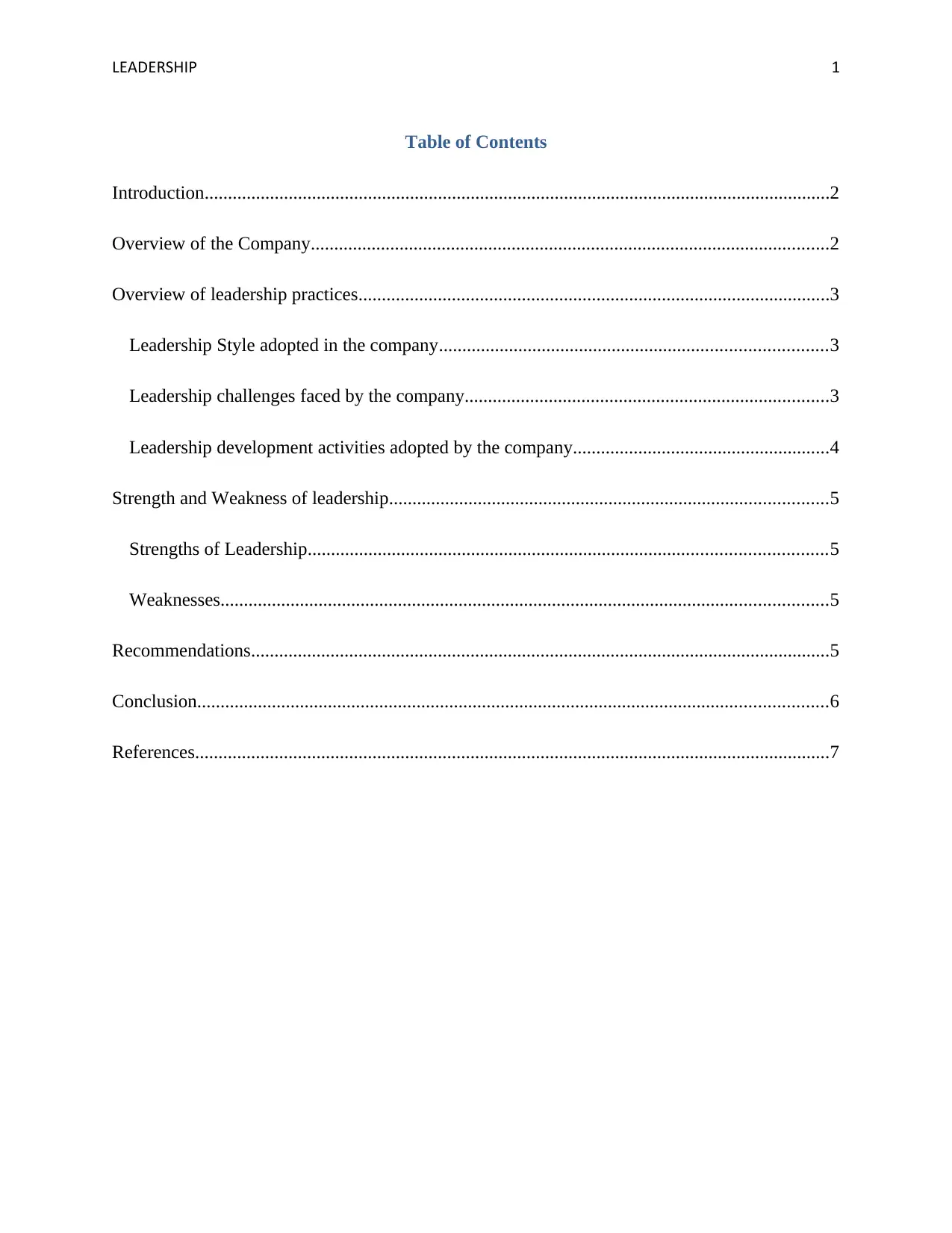
LEADERSHIP 1
Table of Contents
Introduction......................................................................................................................................2
Overview of the Company...............................................................................................................2
Overview of leadership practices.....................................................................................................3
Leadership Style adopted in the company...................................................................................3
Leadership challenges faced by the company..............................................................................3
Leadership development activities adopted by the company.......................................................4
Strength and Weakness of leadership..............................................................................................5
Strengths of Leadership...............................................................................................................5
Weaknesses..................................................................................................................................5
Recommendations............................................................................................................................5
Conclusion.......................................................................................................................................6
References........................................................................................................................................7
Table of Contents
Introduction......................................................................................................................................2
Overview of the Company...............................................................................................................2
Overview of leadership practices.....................................................................................................3
Leadership Style adopted in the company...................................................................................3
Leadership challenges faced by the company..............................................................................3
Leadership development activities adopted by the company.......................................................4
Strength and Weakness of leadership..............................................................................................5
Strengths of Leadership...............................................................................................................5
Weaknesses..................................................................................................................................5
Recommendations............................................................................................................................5
Conclusion.......................................................................................................................................6
References........................................................................................................................................7
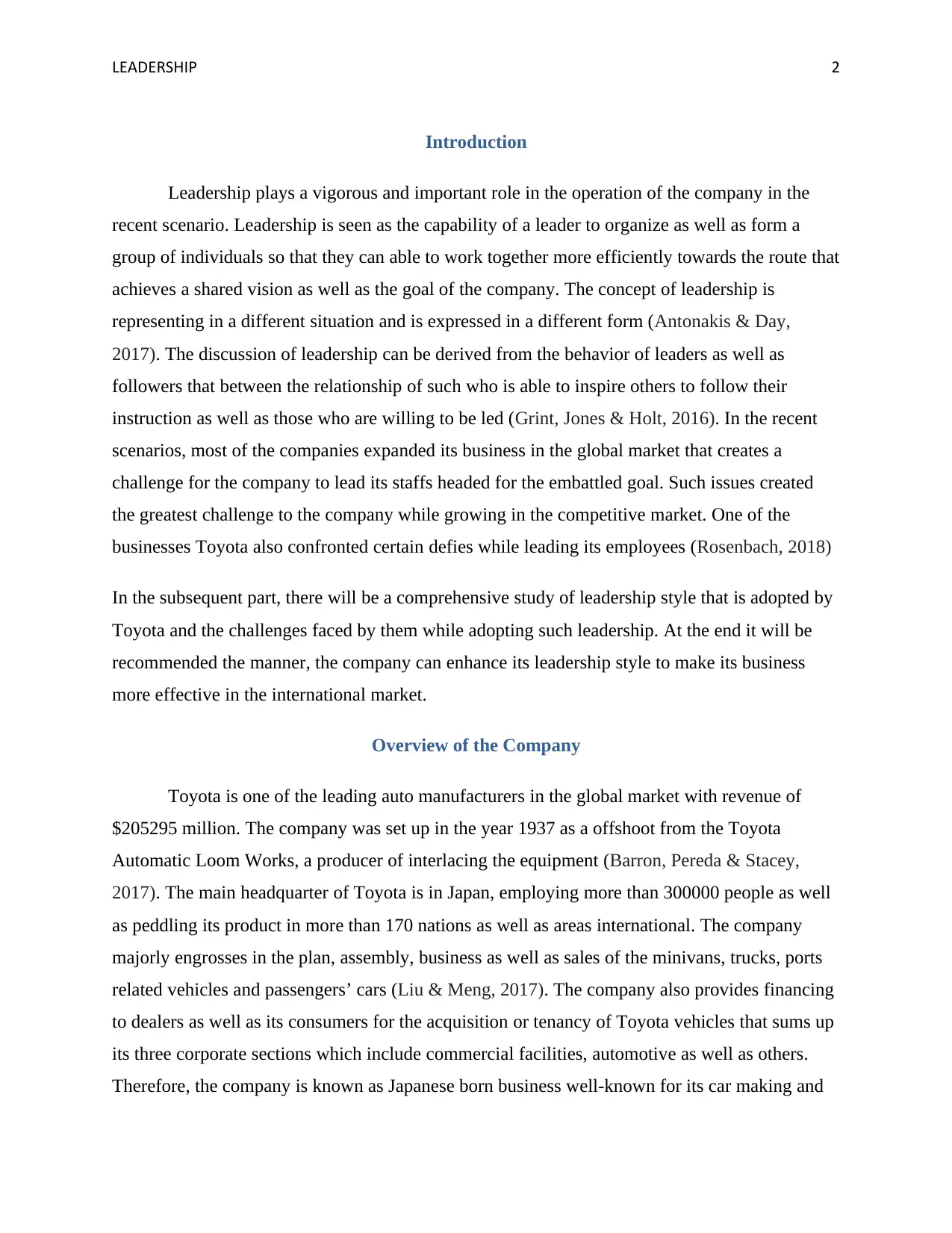
LEADERSHIP 2
Introduction
Leadership plays a vigorous and important role in the operation of the company in the
recent scenario. Leadership is seen as the capability of a leader to organize as well as form a
group of individuals so that they can able to work together more efficiently towards the route that
achieves a shared vision as well as the goal of the company. The concept of leadership is
representing in a different situation and is expressed in a different form (Antonakis & Day,
2017). The discussion of leadership can be derived from the behavior of leaders as well as
followers that between the relationship of such who is able to inspire others to follow their
instruction as well as those who are willing to be led (Grint, Jones & Holt, 2016). In the recent
scenarios, most of the companies expanded its business in the global market that creates a
challenge for the company to lead its staffs headed for the embattled goal. Such issues created
the greatest challenge to the company while growing in the competitive market. One of the
businesses Toyota also confronted certain defies while leading its employees (Rosenbach, 2018)
In the subsequent part, there will be a comprehensive study of leadership style that is adopted by
Toyota and the challenges faced by them while adopting such leadership. At the end it will be
recommended the manner, the company can enhance its leadership style to make its business
more effective in the international market.
Overview of the Company
Toyota is one of the leading auto manufacturers in the global market with revenue of
$205295 million. The company was set up in the year 1937 as a offshoot from the Toyota
Automatic Loom Works, a producer of interlacing the equipment (Barron, Pereda & Stacey,
2017). The main headquarter of Toyota is in Japan, employing more than 300000 people as well
as peddling its product in more than 170 nations as well as areas international. The company
majorly engrosses in the plan, assembly, business as well as sales of the minivans, trucks, ports
related vehicles and passengers’ cars (Liu & Meng, 2017). The company also provides financing
to dealers as well as its consumers for the acquisition or tenancy of Toyota vehicles that sums up
its three corporate sections which include commercial facilities, automotive as well as others.
Therefore, the company is known as Japanese born business well-known for its car making and
Introduction
Leadership plays a vigorous and important role in the operation of the company in the
recent scenario. Leadership is seen as the capability of a leader to organize as well as form a
group of individuals so that they can able to work together more efficiently towards the route that
achieves a shared vision as well as the goal of the company. The concept of leadership is
representing in a different situation and is expressed in a different form (Antonakis & Day,
2017). The discussion of leadership can be derived from the behavior of leaders as well as
followers that between the relationship of such who is able to inspire others to follow their
instruction as well as those who are willing to be led (Grint, Jones & Holt, 2016). In the recent
scenarios, most of the companies expanded its business in the global market that creates a
challenge for the company to lead its staffs headed for the embattled goal. Such issues created
the greatest challenge to the company while growing in the competitive market. One of the
businesses Toyota also confronted certain defies while leading its employees (Rosenbach, 2018)
In the subsequent part, there will be a comprehensive study of leadership style that is adopted by
Toyota and the challenges faced by them while adopting such leadership. At the end it will be
recommended the manner, the company can enhance its leadership style to make its business
more effective in the international market.
Overview of the Company
Toyota is one of the leading auto manufacturers in the global market with revenue of
$205295 million. The company was set up in the year 1937 as a offshoot from the Toyota
Automatic Loom Works, a producer of interlacing the equipment (Barron, Pereda & Stacey,
2017). The main headquarter of Toyota is in Japan, employing more than 300000 people as well
as peddling its product in more than 170 nations as well as areas international. The company
majorly engrosses in the plan, assembly, business as well as sales of the minivans, trucks, ports
related vehicles and passengers’ cars (Liu & Meng, 2017). The company also provides financing
to dealers as well as its consumers for the acquisition or tenancy of Toyota vehicles that sums up
its three corporate sections which include commercial facilities, automotive as well as others.
Therefore, the company is known as Japanese born business well-known for its car making and
⊘ This is a preview!⊘
Do you want full access?
Subscribe today to unlock all pages.

Trusted by 1+ million students worldwide
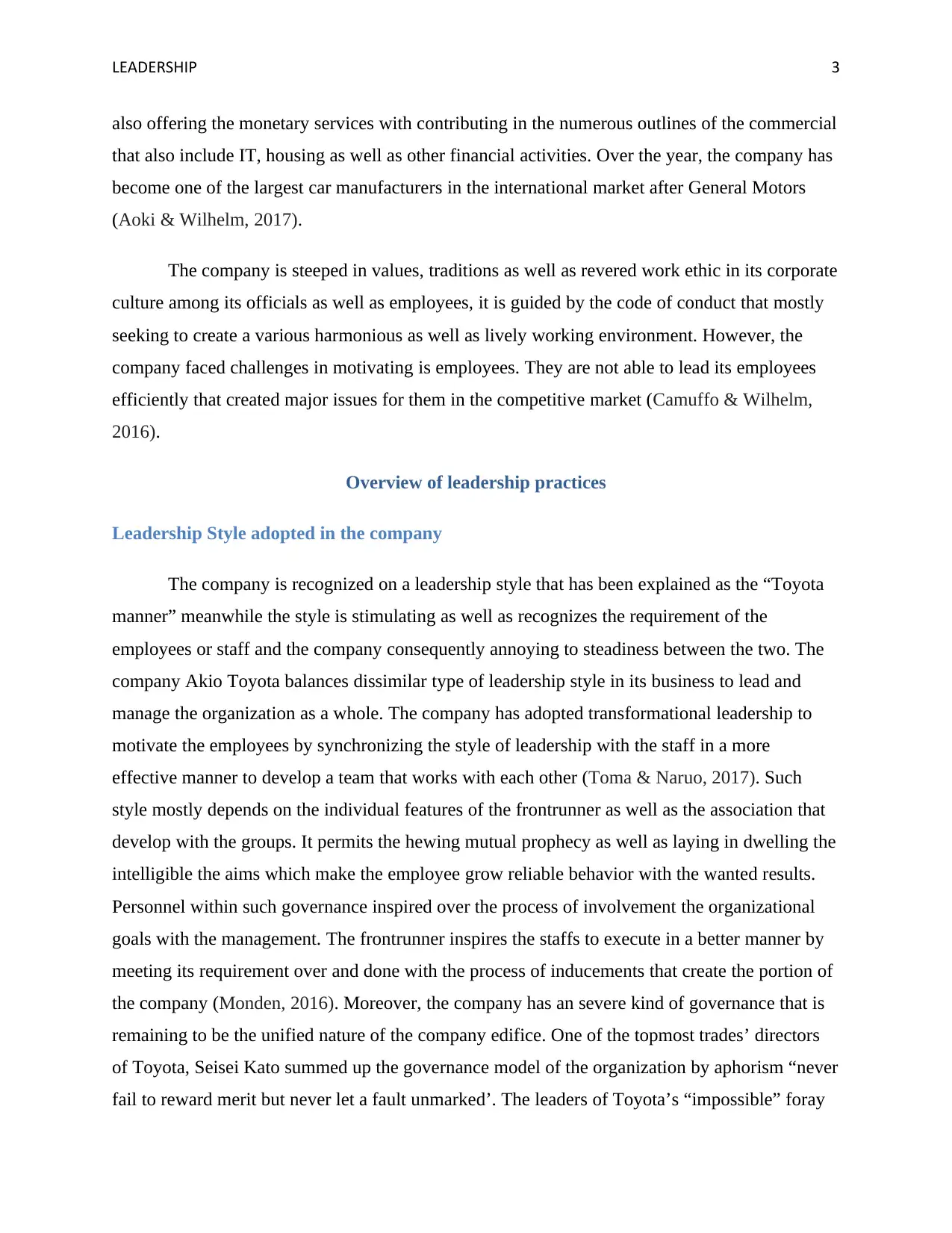
LEADERSHIP 3
also offering the monetary services with contributing in the numerous outlines of the commercial
that also include IT, housing as well as other financial activities. Over the year, the company has
become one of the largest car manufacturers in the international market after General Motors
(Aoki & Wilhelm, 2017).
The company is steeped in values, traditions as well as revered work ethic in its corporate
culture among its officials as well as employees, it is guided by the code of conduct that mostly
seeking to create a various harmonious as well as lively working environment. However, the
company faced challenges in motivating is employees. They are not able to lead its employees
efficiently that created major issues for them in the competitive market (Camuffo & Wilhelm,
2016).
Overview of leadership practices
Leadership Style adopted in the company
The company is recognized on a leadership style that has been explained as the “Toyota
manner” meanwhile the style is stimulating as well as recognizes the requirement of the
employees or staff and the company consequently annoying to steadiness between the two. The
company Akio Toyota balances dissimilar type of leadership style in its business to lead and
manage the organization as a whole. The company has adopted transformational leadership to
motivate the employees by synchronizing the style of leadership with the staff in a more
effective manner to develop a team that works with each other (Toma & Naruo, 2017). Such
style mostly depends on the individual features of the frontrunner as well as the association that
develop with the groups. It permits the hewing mutual prophecy as well as laying in dwelling the
intelligible the aims which make the employee grow reliable behavior with the wanted results.
Personnel within such governance inspired over the process of involvement the organizational
goals with the management. The frontrunner inspires the staffs to execute in a better manner by
meeting its requirement over and done with the process of inducements that create the portion of
the company (Monden, 2016). Moreover, the company has an severe kind of governance that is
remaining to be the unified nature of the company edifice. One of the topmost trades’ directors
of Toyota, Seisei Kato summed up the governance model of the organization by aphorism “never
fail to reward merit but never let a fault unmarked’. The leaders of Toyota’s “impossible” foray
also offering the monetary services with contributing in the numerous outlines of the commercial
that also include IT, housing as well as other financial activities. Over the year, the company has
become one of the largest car manufacturers in the international market after General Motors
(Aoki & Wilhelm, 2017).
The company is steeped in values, traditions as well as revered work ethic in its corporate
culture among its officials as well as employees, it is guided by the code of conduct that mostly
seeking to create a various harmonious as well as lively working environment. However, the
company faced challenges in motivating is employees. They are not able to lead its employees
efficiently that created major issues for them in the competitive market (Camuffo & Wilhelm,
2016).
Overview of leadership practices
Leadership Style adopted in the company
The company is recognized on a leadership style that has been explained as the “Toyota
manner” meanwhile the style is stimulating as well as recognizes the requirement of the
employees or staff and the company consequently annoying to steadiness between the two. The
company Akio Toyota balances dissimilar type of leadership style in its business to lead and
manage the organization as a whole. The company has adopted transformational leadership to
motivate the employees by synchronizing the style of leadership with the staff in a more
effective manner to develop a team that works with each other (Toma & Naruo, 2017). Such
style mostly depends on the individual features of the frontrunner as well as the association that
develop with the groups. It permits the hewing mutual prophecy as well as laying in dwelling the
intelligible the aims which make the employee grow reliable behavior with the wanted results.
Personnel within such governance inspired over the process of involvement the organizational
goals with the management. The frontrunner inspires the staffs to execute in a better manner by
meeting its requirement over and done with the process of inducements that create the portion of
the company (Monden, 2016). Moreover, the company has an severe kind of governance that is
remaining to be the unified nature of the company edifice. One of the topmost trades’ directors
of Toyota, Seisei Kato summed up the governance model of the organization by aphorism “never
fail to reward merit but never let a fault unmarked’. The leaders of Toyota’s “impossible” foray
Paraphrase This Document
Need a fresh take? Get an instant paraphrase of this document with our AI Paraphraser
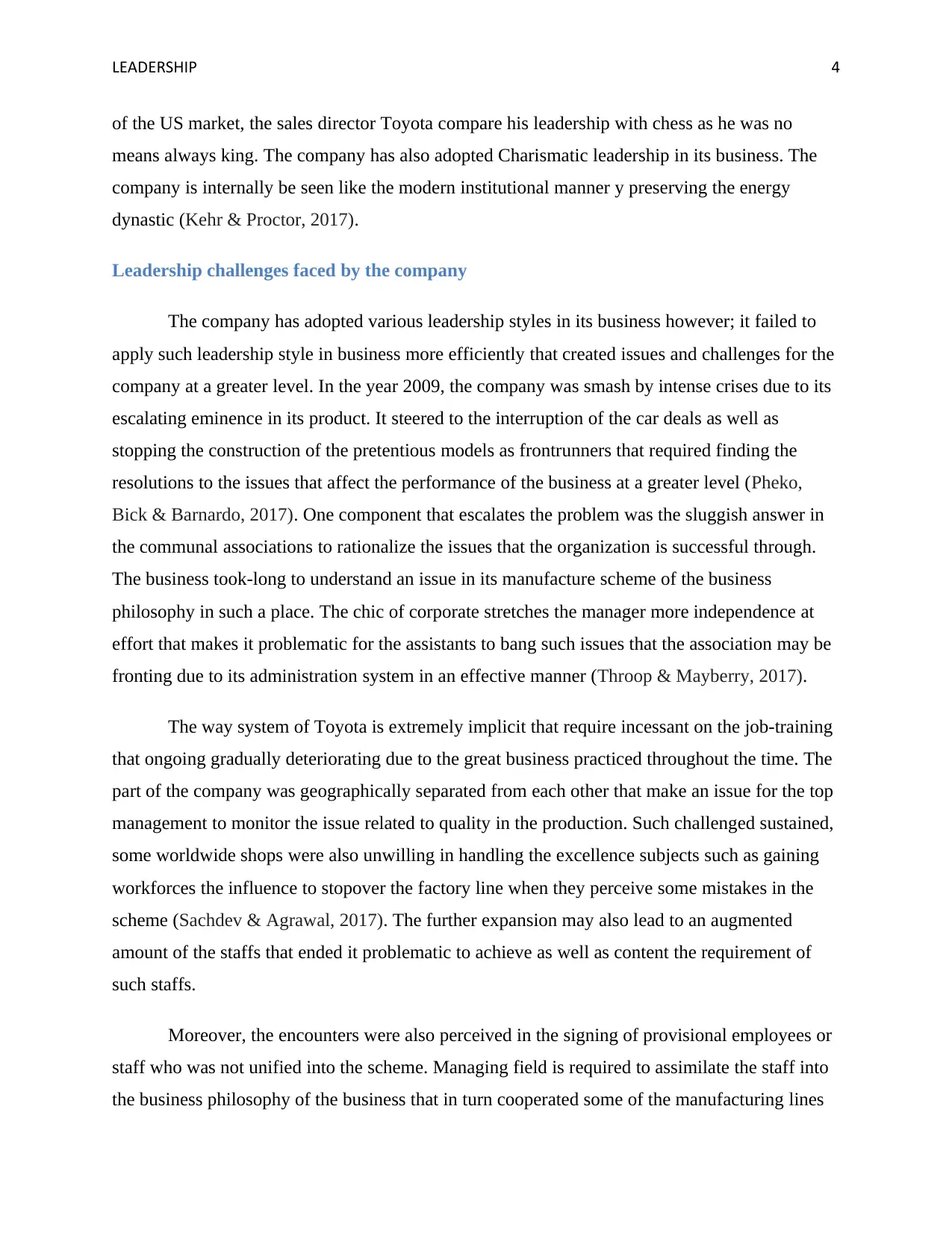
LEADERSHIP 4
of the US market, the sales director Toyota compare his leadership with chess as he was no
means always king. The company has also adopted Charismatic leadership in its business. The
company is internally be seen like the modern institutional manner y preserving the energy
dynastic (Kehr & Proctor, 2017).
Leadership challenges faced by the company
The company has adopted various leadership styles in its business however; it failed to
apply such leadership style in business more efficiently that created issues and challenges for the
company at a greater level. In the year 2009, the company was smash by intense crises due to its
escalating eminence in its product. It steered to the interruption of the car deals as well as
stopping the construction of the pretentious models as frontrunners that required finding the
resolutions to the issues that affect the performance of the business at a greater level (Pheko,
Bick & Barnardo, 2017). One component that escalates the problem was the sluggish answer in
the communal associations to rationalize the issues that the organization is successful through.
The business took-long to understand an issue in its manufacture scheme of the business
philosophy in such a place. The chic of corporate stretches the manager more independence at
effort that makes it problematic for the assistants to bang such issues that the association may be
fronting due to its administration system in an effective manner (Throop & Mayberry, 2017).
The way system of Toyota is extremely implicit that require incessant on the job-training
that ongoing gradually deteriorating due to the great business practiced throughout the time. The
part of the company was geographically separated from each other that make an issue for the top
management to monitor the issue related to quality in the production. Such challenged sustained,
some worldwide shops were also unwilling in handling the excellence subjects such as gaining
workforces the influence to stopover the factory line when they perceive some mistakes in the
scheme (Sachdev & Agrawal, 2017). The further expansion may also lead to an augmented
amount of the staffs that ended it problematic to achieve as well as content the requirement of
such staffs.
Moreover, the encounters were also perceived in the signing of provisional employees or
staff who was not unified into the scheme. Managing field is required to assimilate the staff into
the business philosophy of the business that in turn cooperated some of the manufacturing lines
of the US market, the sales director Toyota compare his leadership with chess as he was no
means always king. The company has also adopted Charismatic leadership in its business. The
company is internally be seen like the modern institutional manner y preserving the energy
dynastic (Kehr & Proctor, 2017).
Leadership challenges faced by the company
The company has adopted various leadership styles in its business however; it failed to
apply such leadership style in business more efficiently that created issues and challenges for the
company at a greater level. In the year 2009, the company was smash by intense crises due to its
escalating eminence in its product. It steered to the interruption of the car deals as well as
stopping the construction of the pretentious models as frontrunners that required finding the
resolutions to the issues that affect the performance of the business at a greater level (Pheko,
Bick & Barnardo, 2017). One component that escalates the problem was the sluggish answer in
the communal associations to rationalize the issues that the organization is successful through.
The business took-long to understand an issue in its manufacture scheme of the business
philosophy in such a place. The chic of corporate stretches the manager more independence at
effort that makes it problematic for the assistants to bang such issues that the association may be
fronting due to its administration system in an effective manner (Throop & Mayberry, 2017).
The way system of Toyota is extremely implicit that require incessant on the job-training
that ongoing gradually deteriorating due to the great business practiced throughout the time. The
part of the company was geographically separated from each other that make an issue for the top
management to monitor the issue related to quality in the production. Such challenged sustained,
some worldwide shops were also unwilling in handling the excellence subjects such as gaining
workforces the influence to stopover the factory line when they perceive some mistakes in the
scheme (Sachdev & Agrawal, 2017). The further expansion may also lead to an augmented
amount of the staffs that ended it problematic to achieve as well as content the requirement of
such staffs.
Moreover, the encounters were also perceived in the signing of provisional employees or
staff who was not unified into the scheme. Managing field is required to assimilate the staff into
the business philosophy of the business that in turn cooperated some of the manufacturing lines
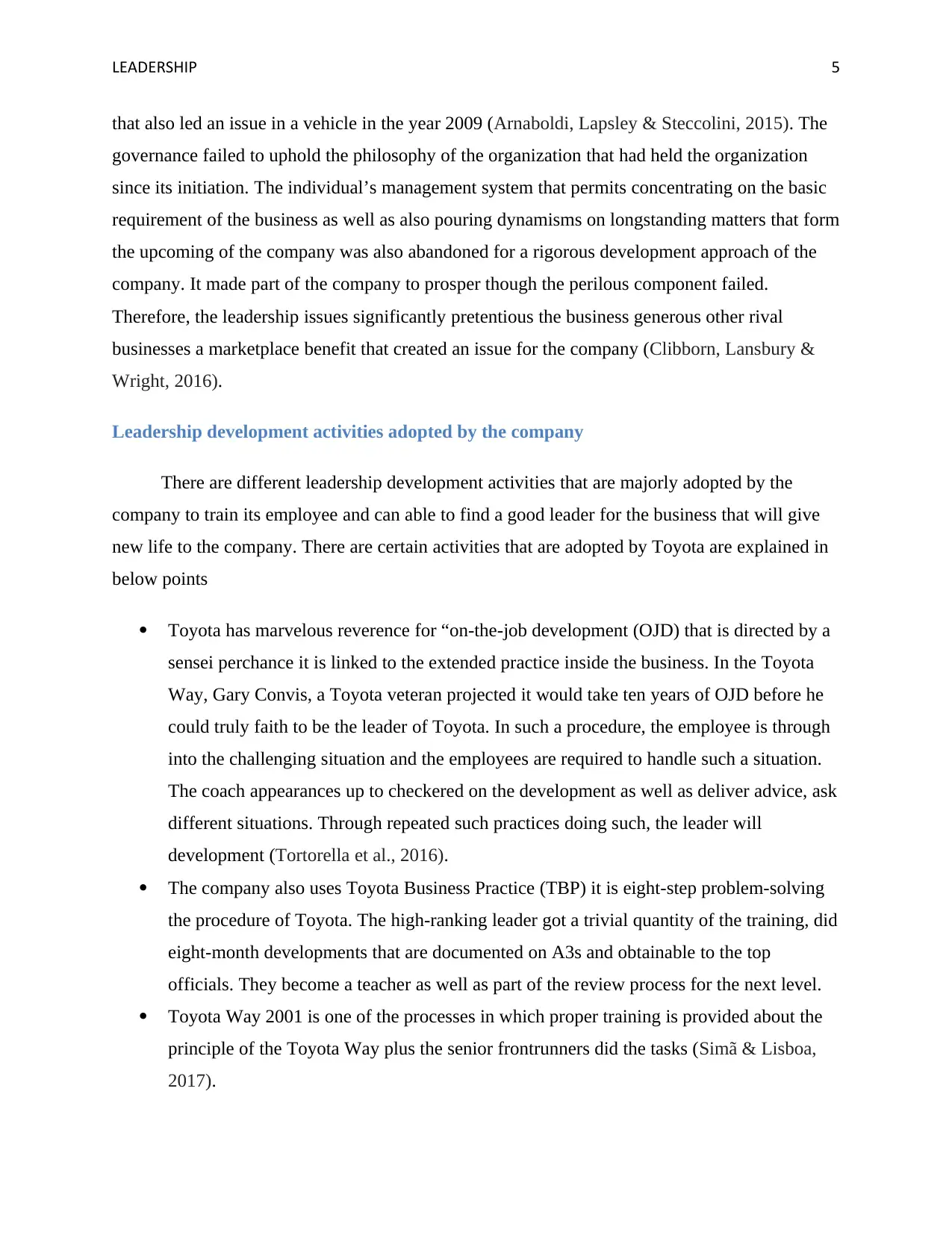
LEADERSHIP 5
that also led an issue in a vehicle in the year 2009 (Arnaboldi, Lapsley & Steccolini, 2015). The
governance failed to uphold the philosophy of the organization that had held the organization
since its initiation. The individual’s management system that permits concentrating on the basic
requirement of the business as well as also pouring dynamisms on longstanding matters that form
the upcoming of the company was also abandoned for a rigorous development approach of the
company. It made part of the company to prosper though the perilous component failed.
Therefore, the leadership issues significantly pretentious the business generous other rival
businesses a marketplace benefit that created an issue for the company (Clibborn, Lansbury &
Wright, 2016).
Leadership development activities adopted by the company
There are different leadership development activities that are majorly adopted by the
company to train its employee and can able to find a good leader for the business that will give
new life to the company. There are certain activities that are adopted by Toyota are explained in
below points
Toyota has marvelous reverence for “on-the-job development (OJD) that is directed by a
sensei perchance it is linked to the extended practice inside the business. In the Toyota
Way, Gary Convis, a Toyota veteran projected it would take ten years of OJD before he
could truly faith to be the leader of Toyota. In such a procedure, the employee is through
into the challenging situation and the employees are required to handle such a situation.
The coach appearances up to checkered on the development as well as deliver advice, ask
different situations. Through repeated such practices doing such, the leader will
development (Tortorella et al., 2016).
The company also uses Toyota Business Practice (TBP) it is eight-step problem-solving
the procedure of Toyota. The high-ranking leader got a trivial quantity of the training, did
eight-month developments that are documented on A3s and obtainable to the top
officials. They become a teacher as well as part of the review process for the next level.
Toyota Way 2001 is one of the processes in which proper training is provided about the
principle of the Toyota Way plus the senior frontrunners did the tasks (Simã & Lisboa,
2017).
that also led an issue in a vehicle in the year 2009 (Arnaboldi, Lapsley & Steccolini, 2015). The
governance failed to uphold the philosophy of the organization that had held the organization
since its initiation. The individual’s management system that permits concentrating on the basic
requirement of the business as well as also pouring dynamisms on longstanding matters that form
the upcoming of the company was also abandoned for a rigorous development approach of the
company. It made part of the company to prosper though the perilous component failed.
Therefore, the leadership issues significantly pretentious the business generous other rival
businesses a marketplace benefit that created an issue for the company (Clibborn, Lansbury &
Wright, 2016).
Leadership development activities adopted by the company
There are different leadership development activities that are majorly adopted by the
company to train its employee and can able to find a good leader for the business that will give
new life to the company. There are certain activities that are adopted by Toyota are explained in
below points
Toyota has marvelous reverence for “on-the-job development (OJD) that is directed by a
sensei perchance it is linked to the extended practice inside the business. In the Toyota
Way, Gary Convis, a Toyota veteran projected it would take ten years of OJD before he
could truly faith to be the leader of Toyota. In such a procedure, the employee is through
into the challenging situation and the employees are required to handle such a situation.
The coach appearances up to checkered on the development as well as deliver advice, ask
different situations. Through repeated such practices doing such, the leader will
development (Tortorella et al., 2016).
The company also uses Toyota Business Practice (TBP) it is eight-step problem-solving
the procedure of Toyota. The high-ranking leader got a trivial quantity of the training, did
eight-month developments that are documented on A3s and obtainable to the top
officials. They become a teacher as well as part of the review process for the next level.
Toyota Way 2001 is one of the processes in which proper training is provided about the
principle of the Toyota Way plus the senior frontrunners did the tasks (Simã & Lisboa,
2017).
⊘ This is a preview!⊘
Do you want full access?
Subscribe today to unlock all pages.

Trusted by 1+ million students worldwide
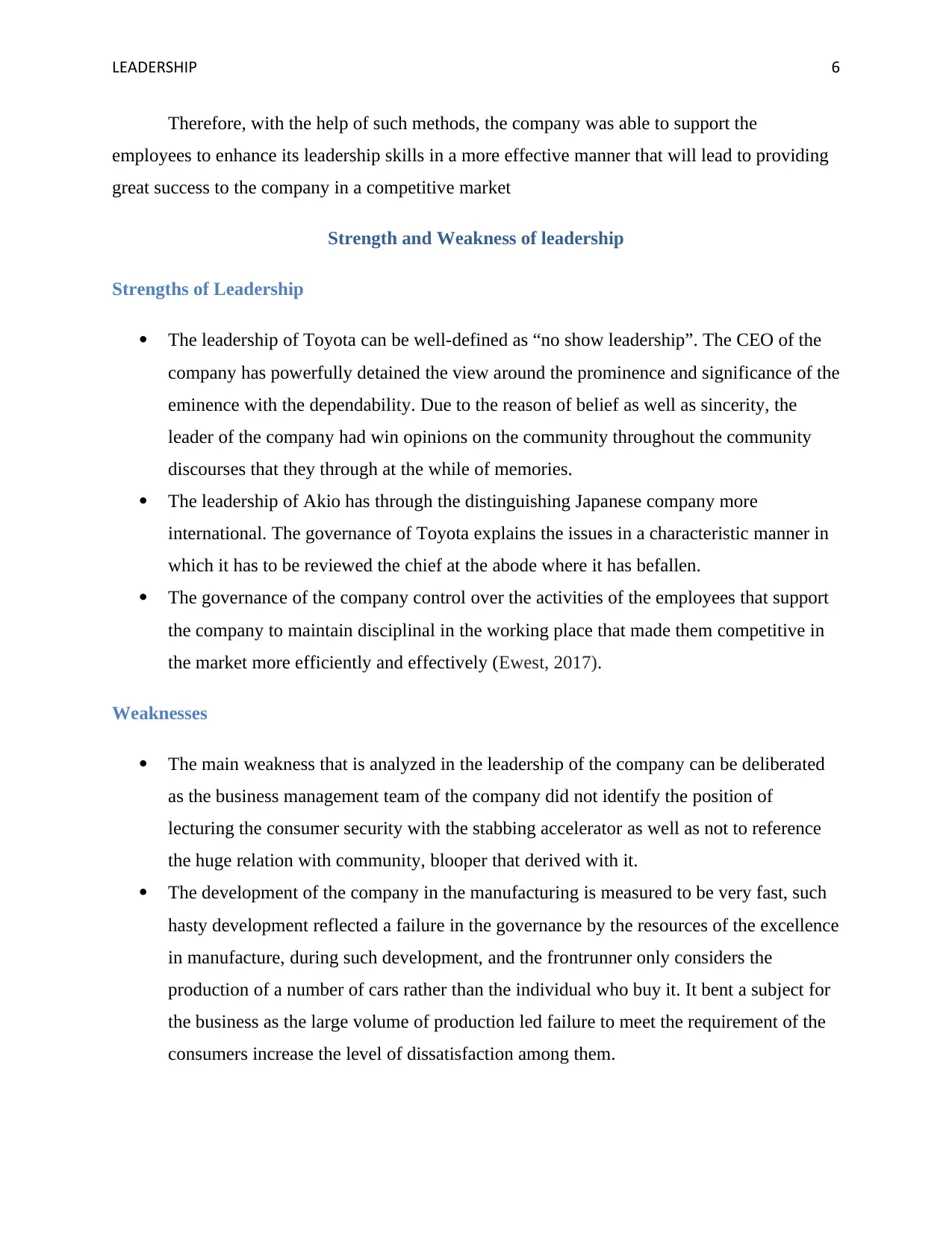
LEADERSHIP 6
Therefore, with the help of such methods, the company was able to support the
employees to enhance its leadership skills in a more effective manner that will lead to providing
great success to the company in a competitive market
Strength and Weakness of leadership
Strengths of Leadership
The leadership of Toyota can be well-defined as “no show leadership”. The CEO of the
company has powerfully detained the view around the prominence and significance of the
eminence with the dependability. Due to the reason of belief as well as sincerity, the
leader of the company had win opinions on the community throughout the community
discourses that they through at the while of memories.
The leadership of Akio has through the distinguishing Japanese company more
international. The governance of Toyota explains the issues in a characteristic manner in
which it has to be reviewed the chief at the abode where it has befallen.
The governance of the company control over the activities of the employees that support
the company to maintain disciplinal in the working place that made them competitive in
the market more efficiently and effectively (Ewest, 2017).
Weaknesses
The main weakness that is analyzed in the leadership of the company can be deliberated
as the business management team of the company did not identify the position of
lecturing the consumer security with the stabbing accelerator as well as not to reference
the huge relation with community, blooper that derived with it.
The development of the company in the manufacturing is measured to be very fast, such
hasty development reflected a failure in the governance by the resources of the excellence
in manufacture, during such development, and the frontrunner only considers the
production of a number of cars rather than the individual who buy it. It bent a subject for
the business as the large volume of production led failure to meet the requirement of the
consumers increase the level of dissatisfaction among them.
Therefore, with the help of such methods, the company was able to support the
employees to enhance its leadership skills in a more effective manner that will lead to providing
great success to the company in a competitive market
Strength and Weakness of leadership
Strengths of Leadership
The leadership of Toyota can be well-defined as “no show leadership”. The CEO of the
company has powerfully detained the view around the prominence and significance of the
eminence with the dependability. Due to the reason of belief as well as sincerity, the
leader of the company had win opinions on the community throughout the community
discourses that they through at the while of memories.
The leadership of Akio has through the distinguishing Japanese company more
international. The governance of Toyota explains the issues in a characteristic manner in
which it has to be reviewed the chief at the abode where it has befallen.
The governance of the company control over the activities of the employees that support
the company to maintain disciplinal in the working place that made them competitive in
the market more efficiently and effectively (Ewest, 2017).
Weaknesses
The main weakness that is analyzed in the leadership of the company can be deliberated
as the business management team of the company did not identify the position of
lecturing the consumer security with the stabbing accelerator as well as not to reference
the huge relation with community, blooper that derived with it.
The development of the company in the manufacturing is measured to be very fast, such
hasty development reflected a failure in the governance by the resources of the excellence
in manufacture, during such development, and the frontrunner only considers the
production of a number of cars rather than the individual who buy it. It bent a subject for
the business as the large volume of production led failure to meet the requirement of the
consumers increase the level of dissatisfaction among them.
Paraphrase This Document
Need a fresh take? Get an instant paraphrase of this document with our AI Paraphraser
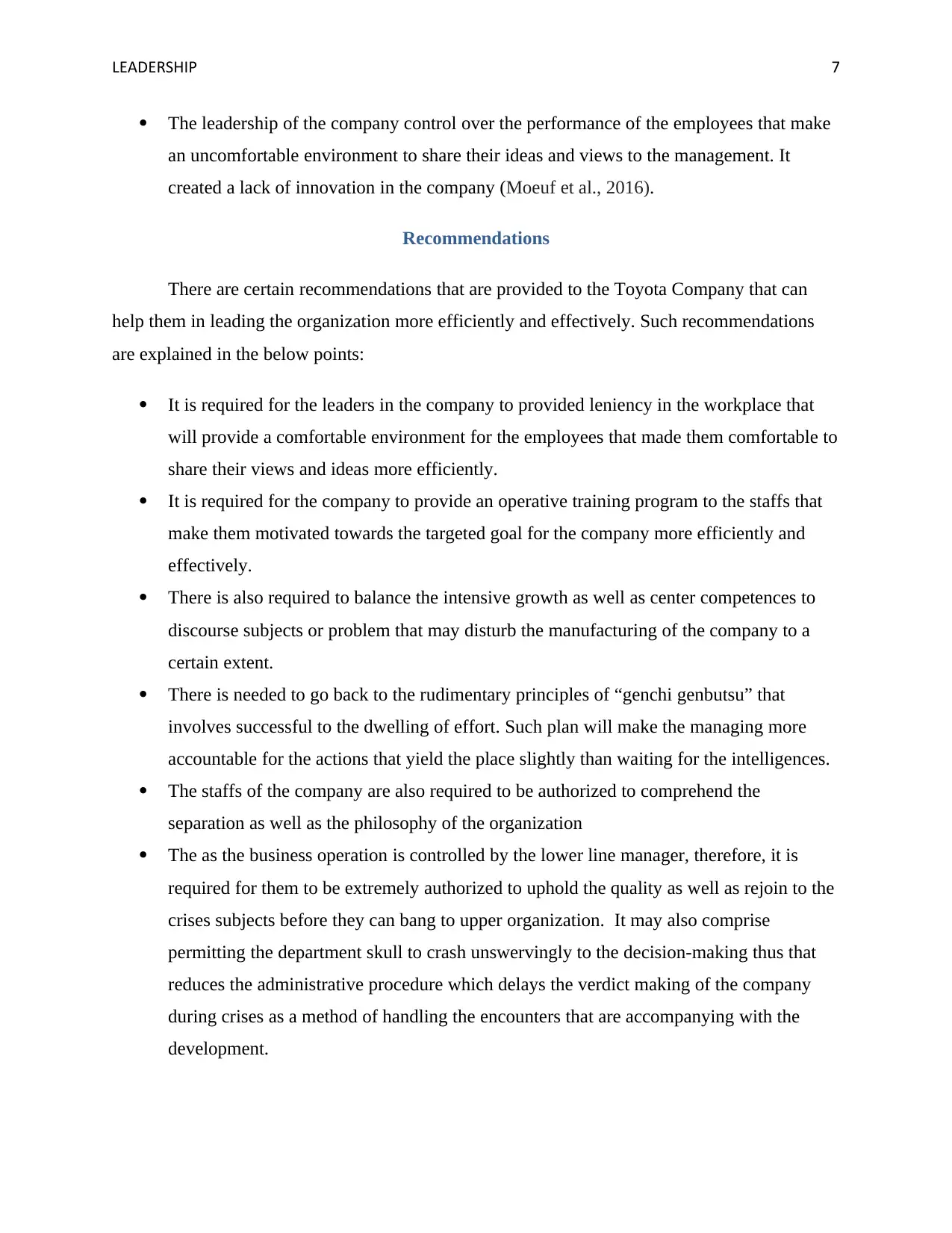
LEADERSHIP 7
The leadership of the company control over the performance of the employees that make
an uncomfortable environment to share their ideas and views to the management. It
created a lack of innovation in the company (Moeuf et al., 2016).
Recommendations
There are certain recommendations that are provided to the Toyota Company that can
help them in leading the organization more efficiently and effectively. Such recommendations
are explained in the below points:
It is required for the leaders in the company to provided leniency in the workplace that
will provide a comfortable environment for the employees that made them comfortable to
share their views and ideas more efficiently.
It is required for the company to provide an operative training program to the staffs that
make them motivated towards the targeted goal for the company more efficiently and
effectively.
There is also required to balance the intensive growth as well as center competences to
discourse subjects or problem that may disturb the manufacturing of the company to a
certain extent.
There is needed to go back to the rudimentary principles of “genchi genbutsu” that
involves successful to the dwelling of effort. Such plan will make the managing more
accountable for the actions that yield the place slightly than waiting for the intelligences.
The staffs of the company are also required to be authorized to comprehend the
separation as well as the philosophy of the organization
The as the business operation is controlled by the lower line manager, therefore, it is
required for them to be extremely authorized to uphold the quality as well as rejoin to the
crises subjects before they can bang to upper organization. It may also comprise
permitting the department skull to crash unswervingly to the decision-making thus that
reduces the administrative procedure which delays the verdict making of the company
during crises as a method of handling the encounters that are accompanying with the
development.
The leadership of the company control over the performance of the employees that make
an uncomfortable environment to share their ideas and views to the management. It
created a lack of innovation in the company (Moeuf et al., 2016).
Recommendations
There are certain recommendations that are provided to the Toyota Company that can
help them in leading the organization more efficiently and effectively. Such recommendations
are explained in the below points:
It is required for the leaders in the company to provided leniency in the workplace that
will provide a comfortable environment for the employees that made them comfortable to
share their views and ideas more efficiently.
It is required for the company to provide an operative training program to the staffs that
make them motivated towards the targeted goal for the company more efficiently and
effectively.
There is also required to balance the intensive growth as well as center competences to
discourse subjects or problem that may disturb the manufacturing of the company to a
certain extent.
There is needed to go back to the rudimentary principles of “genchi genbutsu” that
involves successful to the dwelling of effort. Such plan will make the managing more
accountable for the actions that yield the place slightly than waiting for the intelligences.
The staffs of the company are also required to be authorized to comprehend the
separation as well as the philosophy of the organization
The as the business operation is controlled by the lower line manager, therefore, it is
required for them to be extremely authorized to uphold the quality as well as rejoin to the
crises subjects before they can bang to upper organization. It may also comprise
permitting the department skull to crash unswervingly to the decision-making thus that
reduces the administrative procedure which delays the verdict making of the company
during crises as a method of handling the encounters that are accompanying with the
development.
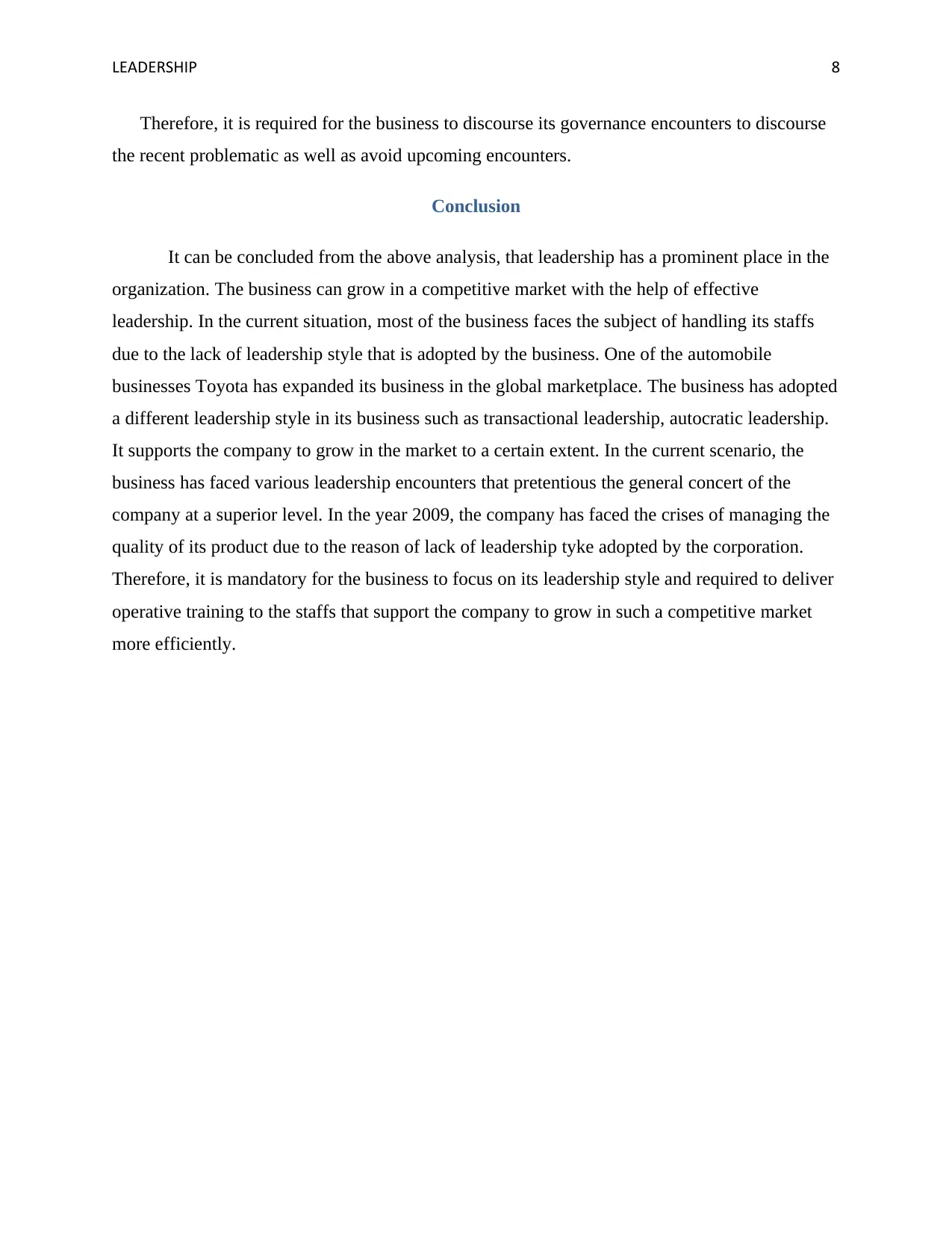
LEADERSHIP 8
Therefore, it is required for the business to discourse its governance encounters to discourse
the recent problematic as well as avoid upcoming encounters.
Conclusion
It can be concluded from the above analysis, that leadership has a prominent place in the
organization. The business can grow in a competitive market with the help of effective
leadership. In the current situation, most of the business faces the subject of handling its staffs
due to the lack of leadership style that is adopted by the business. One of the automobile
businesses Toyota has expanded its business in the global marketplace. The business has adopted
a different leadership style in its business such as transactional leadership, autocratic leadership.
It supports the company to grow in the market to a certain extent. In the current scenario, the
business has faced various leadership encounters that pretentious the general concert of the
company at a superior level. In the year 2009, the company has faced the crises of managing the
quality of its product due to the reason of lack of leadership tyke adopted by the corporation.
Therefore, it is mandatory for the business to focus on its leadership style and required to deliver
operative training to the staffs that support the company to grow in such a competitive market
more efficiently.
Therefore, it is required for the business to discourse its governance encounters to discourse
the recent problematic as well as avoid upcoming encounters.
Conclusion
It can be concluded from the above analysis, that leadership has a prominent place in the
organization. The business can grow in a competitive market with the help of effective
leadership. In the current situation, most of the business faces the subject of handling its staffs
due to the lack of leadership style that is adopted by the business. One of the automobile
businesses Toyota has expanded its business in the global marketplace. The business has adopted
a different leadership style in its business such as transactional leadership, autocratic leadership.
It supports the company to grow in the market to a certain extent. In the current scenario, the
business has faced various leadership encounters that pretentious the general concert of the
company at a superior level. In the year 2009, the company has faced the crises of managing the
quality of its product due to the reason of lack of leadership tyke adopted by the corporation.
Therefore, it is mandatory for the business to focus on its leadership style and required to deliver
operative training to the staffs that support the company to grow in such a competitive market
more efficiently.
⊘ This is a preview!⊘
Do you want full access?
Subscribe today to unlock all pages.

Trusted by 1+ million students worldwide
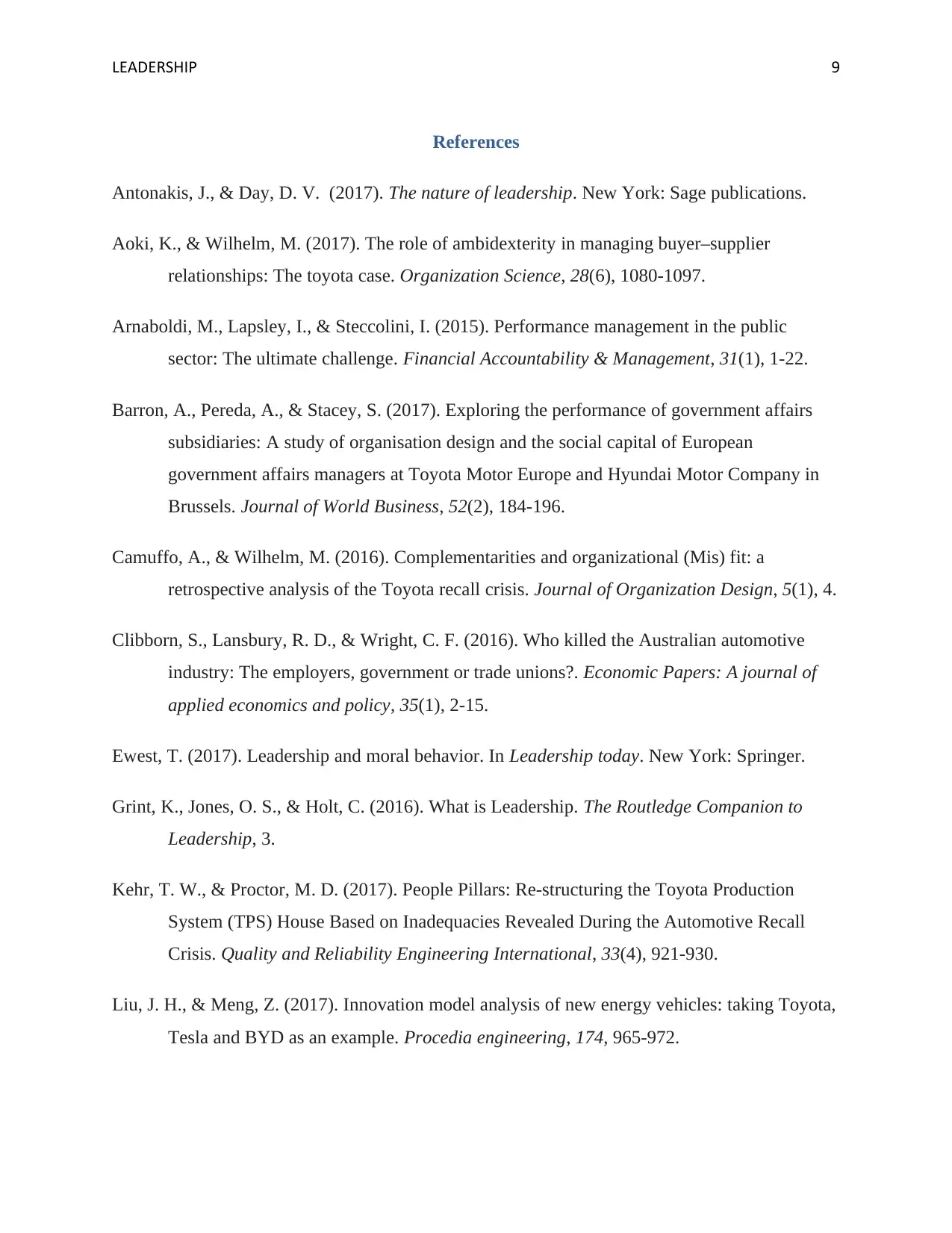
LEADERSHIP 9
References
Antonakis, J., & Day, D. V. (2017). The nature of leadership. New York: Sage publications.
Aoki, K., & Wilhelm, M. (2017). The role of ambidexterity in managing buyer–supplier
relationships: The toyota case. Organization Science, 28(6), 1080-1097.
Arnaboldi, M., Lapsley, I., & Steccolini, I. (2015). Performance management in the public
sector: The ultimate challenge. Financial Accountability & Management, 31(1), 1-22.
Barron, A., Pereda, A., & Stacey, S. (2017). Exploring the performance of government affairs
subsidiaries: A study of organisation design and the social capital of European
government affairs managers at Toyota Motor Europe and Hyundai Motor Company in
Brussels. Journal of World Business, 52(2), 184-196.
Camuffo, A., & Wilhelm, M. (2016). Complementarities and organizational (Mis) fit: a
retrospective analysis of the Toyota recall crisis. Journal of Organization Design, 5(1), 4.
Clibborn, S., Lansbury, R. D., & Wright, C. F. (2016). Who killed the Australian automotive
industry: The employers, government or trade unions?. Economic Papers: A journal of
applied economics and policy, 35(1), 2-15.
Ewest, T. (2017). Leadership and moral behavior. In Leadership today. New York: Springer.
Grint, K., Jones, O. S., & Holt, C. (2016). What is Leadership. The Routledge Companion to
Leadership, 3.
Kehr, T. W., & Proctor, M. D. (2017). People Pillars: Re‐structuring the Toyota Production
System (TPS) House Based on Inadequacies Revealed During the Automotive Recall
Crisis. Quality and Reliability Engineering International, 33(4), 921-930.
Liu, J. H., & Meng, Z. (2017). Innovation model analysis of new energy vehicles: taking Toyota,
Tesla and BYD as an example. Procedia engineering, 174, 965-972.
References
Antonakis, J., & Day, D. V. (2017). The nature of leadership. New York: Sage publications.
Aoki, K., & Wilhelm, M. (2017). The role of ambidexterity in managing buyer–supplier
relationships: The toyota case. Organization Science, 28(6), 1080-1097.
Arnaboldi, M., Lapsley, I., & Steccolini, I. (2015). Performance management in the public
sector: The ultimate challenge. Financial Accountability & Management, 31(1), 1-22.
Barron, A., Pereda, A., & Stacey, S. (2017). Exploring the performance of government affairs
subsidiaries: A study of organisation design and the social capital of European
government affairs managers at Toyota Motor Europe and Hyundai Motor Company in
Brussels. Journal of World Business, 52(2), 184-196.
Camuffo, A., & Wilhelm, M. (2016). Complementarities and organizational (Mis) fit: a
retrospective analysis of the Toyota recall crisis. Journal of Organization Design, 5(1), 4.
Clibborn, S., Lansbury, R. D., & Wright, C. F. (2016). Who killed the Australian automotive
industry: The employers, government or trade unions?. Economic Papers: A journal of
applied economics and policy, 35(1), 2-15.
Ewest, T. (2017). Leadership and moral behavior. In Leadership today. New York: Springer.
Grint, K., Jones, O. S., & Holt, C. (2016). What is Leadership. The Routledge Companion to
Leadership, 3.
Kehr, T. W., & Proctor, M. D. (2017). People Pillars: Re‐structuring the Toyota Production
System (TPS) House Based on Inadequacies Revealed During the Automotive Recall
Crisis. Quality and Reliability Engineering International, 33(4), 921-930.
Liu, J. H., & Meng, Z. (2017). Innovation model analysis of new energy vehicles: taking Toyota,
Tesla and BYD as an example. Procedia engineering, 174, 965-972.
Paraphrase This Document
Need a fresh take? Get an instant paraphrase of this document with our AI Paraphraser
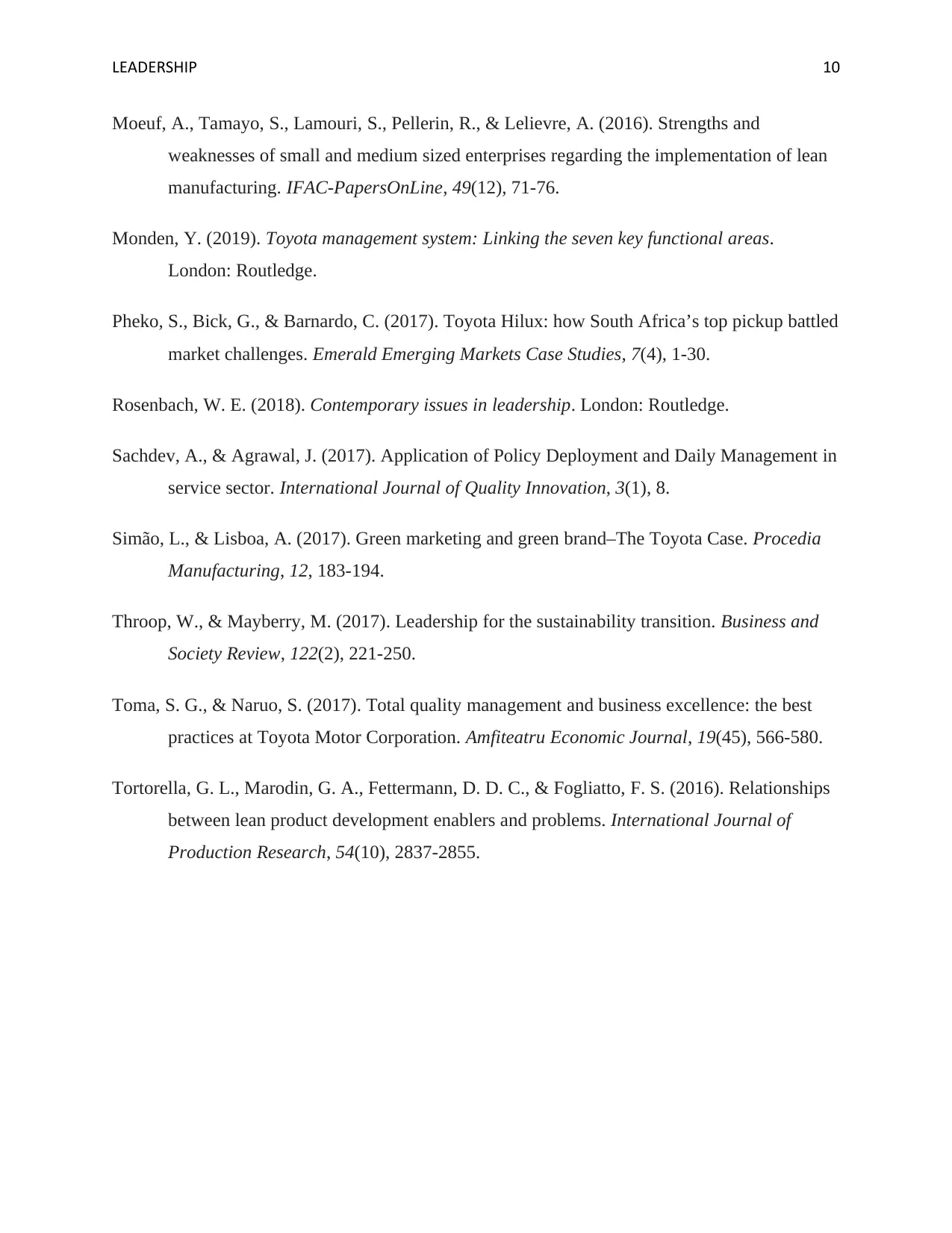
LEADERSHIP 10
Moeuf, A., Tamayo, S., Lamouri, S., Pellerin, R., & Lelievre, A. (2016). Strengths and
weaknesses of small and medium sized enterprises regarding the implementation of lean
manufacturing. IFAC-PapersOnLine, 49(12), 71-76.
Monden, Y. (2019). Toyota management system: Linking the seven key functional areas.
London: Routledge.
Pheko, S., Bick, G., & Barnardo, C. (2017). Toyota Hilux: how South Africa’s top pickup battled
market challenges. Emerald Emerging Markets Case Studies, 7(4), 1-30.
Rosenbach, W. E. (2018). Contemporary issues in leadership. London: Routledge.
Sachdev, A., & Agrawal, J. (2017). Application of Policy Deployment and Daily Management in
service sector. International Journal of Quality Innovation, 3(1), 8.
Simão, L., & Lisboa, A. (2017). Green marketing and green brand–The Toyota Case. Procedia
Manufacturing, 12, 183-194.
Throop, W., & Mayberry, M. (2017). Leadership for the sustainability transition. Business and
Society Review, 122(2), 221-250.
Toma, S. G., & Naruo, S. (2017). Total quality management and business excellence: the best
practices at Toyota Motor Corporation. Amfiteatru Economic Journal, 19(45), 566-580.
Tortorella, G. L., Marodin, G. A., Fettermann, D. D. C., & Fogliatto, F. S. (2016). Relationships
between lean product development enablers and problems. International Journal of
Production Research, 54(10), 2837-2855.
Moeuf, A., Tamayo, S., Lamouri, S., Pellerin, R., & Lelievre, A. (2016). Strengths and
weaknesses of small and medium sized enterprises regarding the implementation of lean
manufacturing. IFAC-PapersOnLine, 49(12), 71-76.
Monden, Y. (2019). Toyota management system: Linking the seven key functional areas.
London: Routledge.
Pheko, S., Bick, G., & Barnardo, C. (2017). Toyota Hilux: how South Africa’s top pickup battled
market challenges. Emerald Emerging Markets Case Studies, 7(4), 1-30.
Rosenbach, W. E. (2018). Contemporary issues in leadership. London: Routledge.
Sachdev, A., & Agrawal, J. (2017). Application of Policy Deployment and Daily Management in
service sector. International Journal of Quality Innovation, 3(1), 8.
Simão, L., & Lisboa, A. (2017). Green marketing and green brand–The Toyota Case. Procedia
Manufacturing, 12, 183-194.
Throop, W., & Mayberry, M. (2017). Leadership for the sustainability transition. Business and
Society Review, 122(2), 221-250.
Toma, S. G., & Naruo, S. (2017). Total quality management and business excellence: the best
practices at Toyota Motor Corporation. Amfiteatru Economic Journal, 19(45), 566-580.
Tortorella, G. L., Marodin, G. A., Fettermann, D. D. C., & Fogliatto, F. S. (2016). Relationships
between lean product development enablers and problems. International Journal of
Production Research, 54(10), 2837-2855.
1 out of 11
Related Documents
Your All-in-One AI-Powered Toolkit for Academic Success.
+13062052269
info@desklib.com
Available 24*7 on WhatsApp / Email
![[object Object]](/_next/static/media/star-bottom.7253800d.svg)
Unlock your academic potential
Copyright © 2020–2025 A2Z Services. All Rights Reserved. Developed and managed by ZUCOL.





